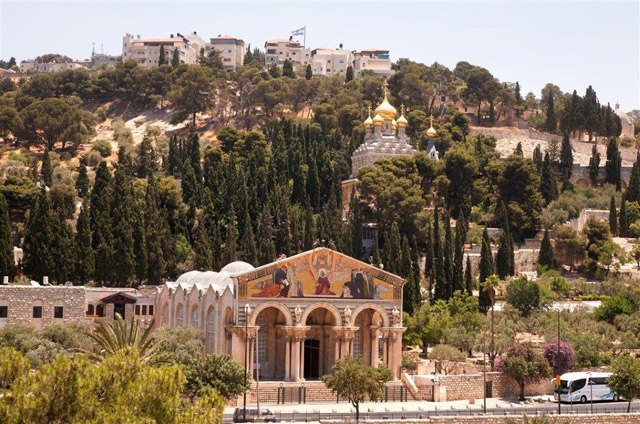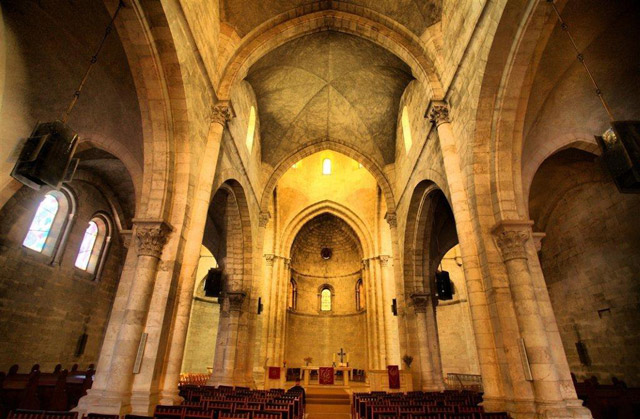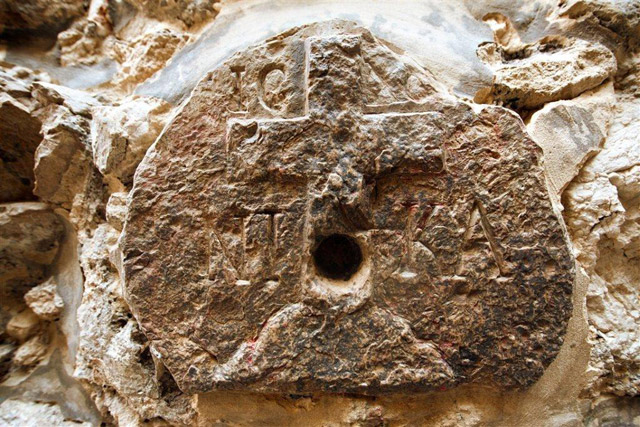(Israel Ministry of Tourism)
There is nothing like experiencing Holy Week in Jerusalem. Celebrating the greatest events of salvation history and of Jesus' life at the very sites where they occurred is a moving and unforgettable experience of faith for all believers.
On Easter and the preceding Holy Week, Jerusalem fills with pilgrims from all over the world. For Orthodox and Catholic Christians, celebrations focus on the Church of the Holy Sepulcher, where six historic denominations have marked the crucifixion, burial and resurrection of Jesus since the fourth century.
On Palm Sunday (March 29), over 1000 Catholic and Protestant pilgrims come streaming down the Mount of Olives singing hymns and bearing palm fronds, reenacting Jesus' Triumphal Entry into Jerusalem. A procession takes place in the afternoon, beginning at the Bethpage Church on the eastern slope of the Mount of Olives and descending into Gethsemane and ending in the Old City at the Church of St. Anne's.

Churches on the Mount of Olives, Jerusalem
Copyright: Israel Ministry of Tourism
The Orthodox denominations follow the Patriarch, bearing palm fronds, in a colorful procession to the Church of the Holy Sepulcher and back to the Patriarchate. Other processions from the Armenian, Coptic and Syrian denominations also take place within the Church of the Holy Sepulcher.
Another highlight is Maundy Thursday (April 2), when the faithful commemorate the Last Supper and the washing of the apostle's feet by Jesus and Christ's last hours prior to his arrest in Gethsemane. The Latin Patriarch washes the feet of his priests in imitation of Jesus in the church of the Holy Sepulcher, the Custodian of the Holy Sites in the Room of the Last Supper and later at Saint Saviour's Church. In the afternoon, a short Catholic prayer service in several languages takes place at the Cenacle, while the Anglican, Lutheran and Protestant denominations hold a procession from St. George's Cathedral to the Redeemer's Church and Christ Church, ending at Gethsemane.

Inside the Lutheran Church of the Redeemer, Jerusalem
Copyright: Israel Ministry of Tourism
At Holy Hour, a reading in several languages will take place in the Basilica of Agony in Gethsemane, with a candlelight procession from Gethsemane to Mount Zion (Catholics). The Church of Saint Peter in Gallicantu remains open to worshippers throughout most of the night. The Orthodox denominations celebrate with a washing of the feet ceremony in the courtyard of the Holy Sepulcher and in the respective churches in the Old City.
On Good Friday (April 3), the day Jesus was crucified and buried, a procession of thousands bearing crosses and led by the Patriarch, the Custodian of the Holy Sites and other independent groups mark the Stations of the Cross along the Via Dolorosa in Jerusalem's Old City to the Calvary in the Church of the Holy Sepulcher. In the evening, a burial procession is held in the Holy Sepulcher (Catholics), in the Old City churches and at the Garden Tomb in Jerusalem (Protestants), where services are also held in English.

8th Station of the Via Dolorosa, Jerusalem
Copyright: Israel Ministry of Tourism
On Holy or Great Saturday(April 4), Orthodox Christians celebrate the Ceremony of the Holy Fire, when thousands gather inside and outside the Church of the Holy Sepulcher to await the miraculous lighting of the Patriarch's candle from within the tomb. This spectacular ceremony is unique and particular to Jerusalem and is broadcast around the world. In addition, the light is brought to Orthodox countries by special flight.
On Easter Sunday (April 5), when the faithful celebrate Jesus' resurrection, the Latin Patriarch heads a procession to the Church of the Holy Sepulcher for a multi-lingual reading of the Gospel of Resurrection and celebration of the Easter Masses. For the Lutherans, the Easter day Eucharist takes place on the Mount of Olives behind the Augusta Victoria Church, and Protestants can partake in the Easter services in English at the Garden Tomb and several Protestant churches in Jerusalem.
Orthodox denominations celebrate Easter Sunday from midnight on Saturday with a Partiarchal procession to the Church of the Holy Sepulcher and celebrations of the Easter Divine Liturgy in the Orthodox Old City churches.
On Easter Monday, (April 6), the celebrations move to Emmaus to commemorate when the resurrected Jesus appeared before two of his disciples and broke bread with them at Emmaus outside Jerusalem. There is discussion about the exact location of Emmaus, near Latrun, Abu Ghosh and al-Qubeibeh (west and northwest of Jerusalem). Solemn masses are held in the various locations, presided over by the Latin Patriarch (Emmaus near Latrun) and by the Franciscan Custos (Emmaus al-Qubeibeh). Many monks walk the 30 kilometers from Jerusalem to Emmaus-Latrun to participate in the afternoon mass, celebrated in the ruins of the Crusader Church.